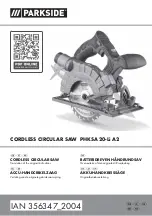
3
TABLE SAW SAFETY
1. ALWAYS USE SAW BLADE GUARD, riving knife and
anti-kickback pawls for every through–sawing operation.
Through–sawing operations are those in which the blade
cuts completely through the workpiece when ripping or
crosscutting. Always be sure blade guard is tightened
securely.
2. ALWAYS HOLD WORKPIECE FIRMLY against the miter
gauge or rip fence.
3. ALWAYS USE a push stick or push block, especially when
ripping narrow stock. Refer to ripping instructions in this
Instruction Manual where the push stick is covered in
detail. A pattern for making your own push stick is
included on page 23.
4. NEVER PERFORM ANY OPERATION FREEHAND, which
means can using hands to support the workpiece, but
always use either the fence OR the miter gauge to
position and guide the workpiece.
DANGER
5. NEVER STAND or have any part of your body in
line with the path of the saw blade. Keep your
hands out of the saw blade path.
FREEHAND CUTTING IS THE MAJOR
CAUSE OF KICKBACK AND FINGER/ HAND
AMPUTATIONS. NEVER USE THE MITER GAUGE
AND FENCE SIMULTANEOUSLY.
6. NEVER REACH behind or over the cutting tool for
any reason.
7. REMOVE the rip fence when crosscutting.
8. DO NOT USE a molding head with this saw.
9. FEED WORK INTO THE BLADE against the direction
of rotation only.
10. NEVER use the rip fence as a cut-off gauge when
crosscutting.
11. NEVER ATTEMPT TO FREE A STALLED SAW BLADE
without first turning the saw OFF. Turn power switch OFF
immediately to prevent motor damage.
12. PROVIDE ADEQUATE SUPPORT to the rear and the
sides of the saw table for long or wide workpieces.
13. AVOID KICKBACKS (work thrown back towards you) by
keeping the blade sharp, the rip fence parallel to the saw
blade and by keeping the splitter, anti-kickback pawls and
guards in place, aligned and functioning. Do not release
work before passing it completely beyond the saw blade.
Do not rip work that is twisted, warped or does not have
a straight edge to guide it along the fence. Do not attempt
to reverse out of a cut with the blade running.
14. AVOID AWKWARD OPERATIONS and hand positions
where a sudden slip could cause your hand to move into
the saw blade.
15. NEVER USE SOLVENTS to clean plastic parts. Solvents
could possibly dissolve or otherwise damage the material.
Only a soft damp cloth should be used to clean plastic
parts.
16. MOUNT your table saw on a bench or stand before
performing any cutting operations. Refer to ASSEMBLY
AND ADJUSTMENT on page 9.
17. NEVER CUT METALS or masonry products with this tool.
This table saw is designed for use on wood and woodlike
products only.
18. ALWAYS USE IN A WELL VENTILATED AREA. Remove
sawdust frequently. Clean out sawdust from the interior
of the saw to prevent a potential fire hazard.
19. NEVER LEAVE THE SAW RUNNING UNATTENDED. Do
not leave the saw until the blade comes to a complete stop.
20. For proper operation follow the instructions in this
Instruction Manual entitled ASSEMBLY AND
ADJUSTMENTS (Page 9). NOTE: On machines with no
stand or if stand is not being used, a hole approximately
11 in. square must be cut under saw to allow sawdust to
fall through. Failure to provide sawdust fall-through and
removal hole will allow sawdust to build up in the motor
area resulting in a fire hazard and potential motor damage.
21. USE ONLY saw blades recommended with the warning
that the riving knife shall not be thicker than the width of
the groove cut by the saw blade and not thinner than the
body of the saw blade.
22. USE PUSH-STICK OR PUSH BLOCK to feed the workpiece
past the saw blade. The push-stick or push block should
always be stored with the machine when not in use.
23. DIRECTION OF FEED. Feed workpiece into a blade or
cutter against the direction of rotation of the blade or
cutter only. Never feed material from the back of the saw
as the blade can launch the workpiece at great velocity
across the tabletop.
24. NEVER OPERATE THE SAW ON THE FLOOR.
25. DOUBLE CHECK ALL SETUPS. Make sure the blade is
tight and not making contact with saw or workpiece
before connecting to power supply. Make sure the table
insert and all guards are tight and in place.
26. NEVER ATTEMPT TO PLUNGE CUT INTO A
WORKPIECE by placing it on top of the spinning blade.
The workpiece will kickback.
27. USE THE PROPER TABLE INSERT FOR THE WIDTH
AND DIAMETER OF THE DADO BLADE. Be sure to
check that the blade does not contact the insert before
plugging in and turn on the saw. Never perform bevel
cuts with the dado blade.
28. NEVER GANG CROSSCUT, lining up more than one
workpiece in front of the blade (stacked vertically, or
horizontally outward of the table) and then pushing thru saw
blade. The blade could pick up one or more pieces and
cause a binding or loss of control and possible injury.
29. MAKE SURE THE TABLE INSERT IS FLUSH OR
SLIGHTLY BELOW THE TABLE SURFACE on all sides
except the rear. NEVER operate the saw unless the
proper insert is installed.
30. FOLLOW ALL SAFETY INSTRUCTION LABELS THAT
APPEAR ON THE FRONT OR SIDE OF YOUR TABLE
SAW.





































